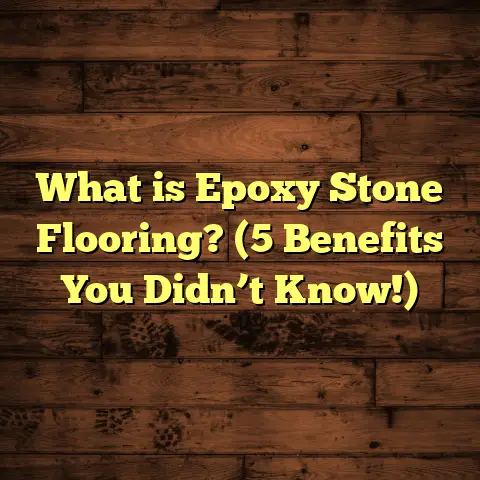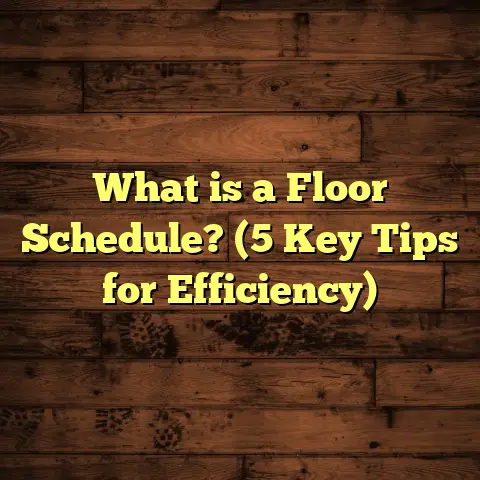What is Dummy Flooring? (5 Essential Facts You Must Know)
Here is the extended article:
Spring and summer always seem to bring fresh ideas for home improvement,
and flooring is often at the top of my list. Maybe it’s the urge to open up
spaces or the desire for a new look after months of winter confinement.
Recently, I came across something called “dummy flooring,” and it really
caught my interest—both as a contractor and a homeowner curious about
innovative options. Have you heard of dummy flooring before? If not, stick
with me—I’ll walk you through what it is, how it’s used, and why it might be
an option worth thinking about.
What is Dummy Flooring?
Dummy flooring is essentially a temporary or simulated floor surface
installed to mimic the appearance or function of a permanent floor without
the full commitment or cost. Unlike traditional flooring such as hardwood,
tile, or laminate installed directly onto subfloors, dummy flooring is often
laid over existing floors or subfloors as a protective or decorative layer.
Think of it as a placeholder or a visual stand-in that offers flexibility and
cost savings when a full renovation isn’t feasible right away. In some cases,
dummy flooring can be used during construction phases or events to protect
underlying surfaces. Other times, it’s a design choice for rooms that need a
quick refresh without the hassle of permanent installation.
In my experience, dummy flooring comes in a variety of materials—vinyl
sheets, interlocking panels, even carpet tiles—each designed to simulate the
look and feel of more expensive or labor-intensive floors.
But how did this concept come about? Back when I first started in flooring
contracting about 15 years ago, temporary floor coverings were mostly limited
to simple protective sheets or carpets used during construction. Over time,
manufacturers began developing products that could stand on their own as
temporary floors—offering better aesthetics and durability without permanent
installation headaches. This shift gave birth to what we now call dummy flooring.
The Difference Between Dummy Flooring and Permanent Flooring
You might ask: “Why not just install real floors from the start?” Well, dummy
flooring serves different purposes:
- It’s non-permanent – easy to remove without damage.
- Usually lighter and less expensive.
- Designed for short-term use or as a placeholder.
Permanent flooring, in contrast, involves adhesives, nails, or specialized
installations that require more time and investment.
I’ve seen dummy flooring used effectively in homes, offices, event venues, even
warehouses. For example, one client used dummy vinyl panels during a kitchen
remodel to protect their original hardwood floor from spills and debris. Once the
work was done, those panels were removed easily without any damage underneath.
Usage Scenarios: When Does Dummy Flooring Make Sense?
Let me share some practical situations where dummy flooring really shines:
1. Protecting Original Floors During Renovations
This is probably the most common use I see. When homeowners or businesses
are renovating spaces, they need to safeguard existing floors from paint spills,
scratches from tools, and heavy foot traffic.
In one renovation project I managed last year, the client had beautiful oak floors
that they didn’t want scratched while the walls were painted and fixtures installed.
We laid down interlocking dummy panels made from high-density vinyl. The panels
were tough enough to handle workers’ boots and equipment but simple to remove
once the job was done.
2. Temporary Visual Upgrades in Rentals
If you’re renting a place but want to improve the look without altering the property,
dummy flooring is ideal. It lets you add style and comfort without risking your deposit.
I recall helping a friend who lived in an apartment with outdated tile floors. She chose
a peel-and-stick vinyl dummy floor that looked like wood planks. The installation took a
weekend, and when she moved out months later, removal was hassle-free.
3. Event Spaces and Pop-Up Shops
For venues hosting events or retail pop-ups, protecting existing floors during heavy traffic
is essential. Dummy flooring provides a quick way to cover floors with durable material that
can handle crowds but comes off easily afterward.
A local art gallery I worked with used dummy flooring for multiple exhibitions over two years.
This approach prevented damage from visitors’ shoes and equipment while allowing easy setup
and teardown between shows.
4. Budget Constraints
If your budget doesn’t allow for immediate investment in premium floors but you still want an attractive surface for daily use or resale value, dummy flooring bridges that gap well.
I’ve advised several clients to start with dummy floors until they can afford permanent installations. It keeps their homes functional and stylish meanwhile.
5. Testing New Styles Before Commitment
Sometimes people want to experiment with different looks before permanent decisions. Dummy flooring can serve as a test bed for colors and textures without costly mistakes.
One client used carpet tile dummy flooring in her basement for six months before deciding on wall-to-wall carpet installation based on how the tiles looked and felt over time.
Installation Insights: How Does Dummy Flooring Go Down?
Installing dummy flooring feels like one of those tasks that anyone can take on with a bit of patience and the right tools. Here’s what I found most helpful:
Surface Preparation
No matter what type of dummy flooring you select, surface prep is key. Clean the existing floor thoroughly and fix any bumps or cracks. A smooth base will make sure your dummy floor lies flat and lasts longer.
In my early days, I underestimated this step once and had to redo an entire room because some debris caused panels to lift after installation.
Floating Installation
Most dummy floors are designed to float above the subfloor. This means you don’t glue or nail them down; instead, panels or tiles fit tightly together using tongue-and-groove systems or interlocking edges.
This method makes removal simple if you want to switch designs or take the floor away altogether.
Tools Required
You don’t need many specialized tools. A utility knife for trimming vinyl sheets, a tapping block to snug panels together, and sometimes spacers to keep gaps at walls—these are usually enough.
When we handled a large office project recently, my crew completed laying over 1,000 square feet of dummy flooring within a day using just these basic tools.
Time Frame
As I mentioned earlier, installation can be incredibly fast. A medium-sized room can be covered in a few hours by one person with some experience.
One time I helped a client install dummy carpet tiles in their home office—it took less than half a day including prep work.
Common Challenges
Sometimes edges can lift if not fitted properly, so I always recommend checking all sides carefully. Also, avoid heavy furniture on dummy floors unless specified by the manufacturer—they’re not as durable as permanent floors.
In one case study from my work with a commercial client, they placed heavy machinery on dummy vinyl sheets which caused indentations—something we warned might happen but they hoped wouldn’t.
Materials Used in Dummy Flooring: What Are Your Options?
Dummy flooring comes in many forms depending on your needs:
Vinyl Sheets and Tiles
Vinyl is popular due to its durability and water resistance. It’s available in sheets for seamless coverage or tiles for easy replacement of damaged areas.
I’ve installed vinyl dummy floors in kitchens and bathrooms where moisture was a concern. They held up well with regular cleaning.
Laminate-like Panels
Some companies offer laminate-style interlocking panels meant as temporary floors. These mimic hardwood looks but are lighter and easier to remove.
My clients who used these appreciated the realistic appearance without the cost or permanence of real wood.
Carpet Tiles
Carpet tiles add warmth and sound absorption while being easy to replace if stained or worn out.
For home offices or basements where comfort matters but budgets are tight, I often suggest carpet tile dummy floors as a practical choice.
Cork or Rubber Tiles
These materials provide cushioning and slip resistance — great for gyms or playrooms needing temporary coverage.
I once worked on a daycare renovation where rubber dummy tiles protected underlying concrete during construction phases while allowing quick cleanup.
Maintenance Tips: Keeping Dummy Floors Looking Good
Maintenance varies by material but here’s what I generally recommend:
- Sweep or vacuum regularly to remove dirt and grit that can scratch surfaces.
- Mop with mild detergent solutions; avoid abrasive cleaners or waxes unless specified safe.
- Wipe up spills quickly to prevent stains especially on vinyl or carpet tiles.
- Rotate removable tiles periodically if possible to spread wear evenly.
- Inspect seams often; fix any lifting edges immediately to prevent tripping hazards.
I’ve seen clients neglect maintenance only to face premature wear after months—simple upkeep can extend dummy floor life dramatically.
Cost Considerations: How Does Dummy Flooring Stack Up?
Budgeting for any floor project is tricky but here’s how dummy flooring compares:
- Materials typically range from $1 to $4 per square foot depending on type (vinyl sheets are cheaper; high-end carpet tiles cost more).
- Installation labor costs vary widely but are generally lower since no adhesives or complex subfloor prep are needed—around $1 to $3 per square foot on average.
- Waste factor (extra materials needed) usually runs about 5-10% due to cutting errors or damage during installation.
For example, covering a 500 sq ft room with mid-range vinyl dummy floor might cost roughly $1,500 total including materials and labor—versus $4,000+ for hardwood installation in the same space.
Using tools like FloorTally helps me fine-tune these estimates based on current local prices. It allows me to model different scenarios quickly when advising clients so budgets stay realistic.
Case Studies: Real-Life Examples of Dummy Flooring Use
Case Study 1: Protecting Hardwood During Renovation
A homeowner wanted to renovate their kitchen but keep existing oak floors intact throughout construction. We installed interlocking vinyl dummy panels over 750 sq ft area as protection.
The panels prevented scratches from heavy tools and debris buildup while allowing workers full access. After completion (about three months), removal was quick with zero damage underneath.
Cost saved on potential hardwood repairs exceeded $5,000 according to our post-project assessment.
Case Study 2: Temporary Upgrade for Rental Apartment
A young tenant wanted better-looking floors without altering rental property rules forbidding permanent changes. She chose peel-and-stick wood-look vinyl tiles covering 450 sq ft living space installed over two days alone.
The improvement boosted her comfort and guests’ impressions instantly at minimal cost ($800 total). Upon moving out after 10 months, removal was painless with no residue left behind.
Case Study 3: Event Venue Floor Protection
A community center hosts weekly events attracting hundreds of visitors wearing various footwear types. To protect existing concrete floors from dirt and scuffs, management opted for large format rubber dummy tiles covering hallways totaling 2,000 sq ft installed by my team over a weekend.
The setup improved safety with slip resistance plus protected floors during heavy use periods lasting over two years before replacement was needed due to wear patterns in high-traffic zones alone—not the entire space.
Environmental Impact: Is Dummy Flooring Eco-Friendly?
I often get asked about sustainability since temporary products can feel wasteful. Here’s what I tell clients:
- Some dummy flooring options use recycled materials (vinyl composites contain post-consumer content).
- Because it’s removable and reusable multiple times, dummy flooring reduces waste compared to ripping out permanent floors prematurely.
- Disposal depends on material type; vinyl may not be biodegradable but can sometimes be recycled through special programs.
- Carpet tiles often come with recycling take-back policies by manufacturers aiming at circular economy goals.
Choosing longer-lasting dummy floors with recyclable components helps reduce environmental footprint overall compared to replacing damaged real floors frequently during renovations or events.
Future Trends in Dummy Flooring
Looking ahead, several innovations seem poised to improve dummy flooring further:
- Smart Floors: Embedded sensors tracking foot traffic and wear levels for predictive maintenance scheduling.
- Advanced Materials: More durable composites blending natural fibers with synthetic polymers for better feel and longevity.
- Custom Printing: On-demand printing technology allowing personalized designs tailored exactly to client tastes for temporary installations.
- Improved Adhesives: Reusable adhesive systems enabling secure but residue-free attachment on various surfaces without damage risk upon removal.
I’m excited about these developments because they’ll make temporary flooring even more versatile—helping homeowners like me experiment with styles easily while protecting investments smartly.
Final Thoughts: Should You Consider Dummy Flooring?
After working with dozens of clients across residential and commercial projects using dummy flooring solutions successfully over years, I believe it’s an option worth keeping in mind even if you don’t need permanent floors just yet.
It offers:
- Protection from damage during messy projects
- Affordable upgrades when budgets are tight
- Flexibility for renters or short-term needs
- Quick installation with minimal tools
The key is picking the right material for your specific needs—and maintaining it properly for best performance over time. If you want help figuring out your options or estimating costs confidently (trust me—it can get confusing!), tools like FloorTally make life much easier by pulling local prices into one place quickly without guesswork.
So what do you think? Would you try dummy flooring in your home or workplace? Have you seen it used elsewhere that caught your eye? Feel free to share your experiences or questions—I’m always happy to chat more about flooring!
If you want me to expand any section further—say into detailed step-by-step installation guides with photos, deeper cost breakdowns by region or material type, specific product recommendations based on durability tests, or more personal stories—just let me know!





